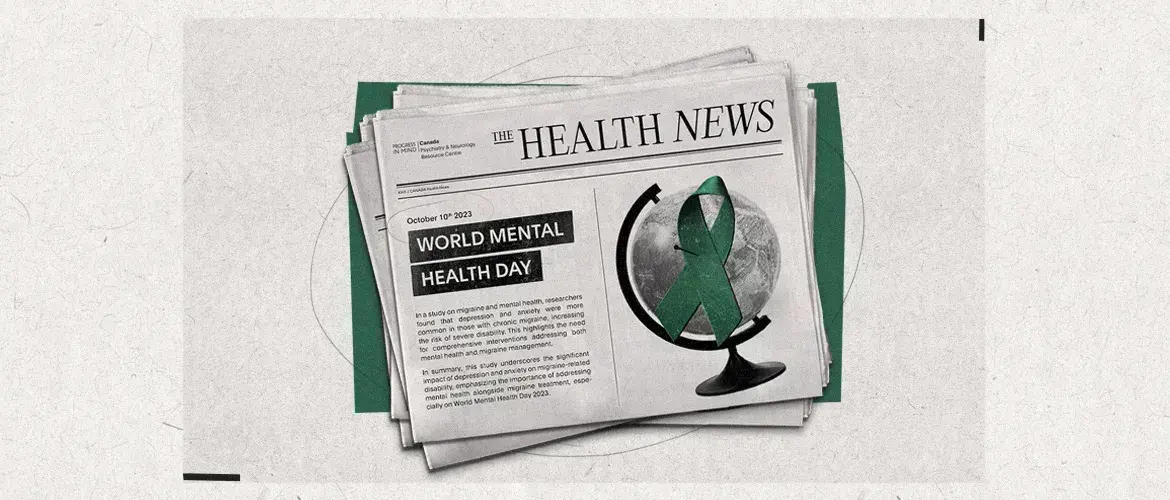On October 10, 2023, the World Health Organization invites people and communities to unite behind the theme for this year’s World Mental Health Day, “Mental health is a universal human right” for all people. This includes the right to be protected from mental health risks, which is particularly pertinent for people living with migraine given their higher risk of depression and anxiety and the profoundly negative impact these comorbidities have on headache-related disability and quality of life. These negative associations were clearly demonstrated in a subanalysis of the Chronic Migraine Epidemiology and Outcomes (CaMEO) Study published by Richard B. Lipton and colleagues and published in the journal Headache.1
Several epidemiological studies have previously highlighted the common co-occurrence and burden of depression and anxiety in people with migraine, particularly those with chronic migraine (CM). However, the bi-directional associations between depression and anxiety with disability in people with migraine had not been specifically evaluated. The objectives of the CaMEO Study were to characterize headache symptoms, severity, disability, comorbidities, and other variables in a large representative sample of U.S. people living with migraine. In a subanalysis of the study, the separate and joint associations between depression and anxiety on migraine disability, adjusted for headache frequency, were investigated to identify unmet needs and to help guide treatment planning.
The CaMEO study included 16,788 people with migraine in the U.S. who completed an Internet survey
People with CM have an increased risk of depression and anxiety
Overall, 32% of survey respondents met clinical criteria for depression and 30% met criteria for anxiety using validated self-rating scales and cutoffs (9-item Patient Health Questionnaire [PHQ-9] score ≥10 and 7-item Generalized Anxiety Disorder Scale [GAD-7] score ≥10, respectively), and 23% had met clinical criteria for both psychiatric disorders. Consistent with earlier studies, the prevalence of depression and anxiety were significantly higher in the subgroup of respondents with CM (57% and 48%) relative to those with episodic migraine (EM; 30% and 28%).
One-third of people with migraine have depression, one-third have anxiety, and nearly one-quarter have both
Rates of moderate-to-severe headache-related disability according to the Migraine Disability Assessment Scale (MIDAS score ≥11) were also significantly increased in the presence of depression (52%) or anxiety (43%) or both (61%) compared to people with neither depression nor anxiety (28%). MIDAS scores increased with the frequency of monthly headache days, suggesting that there is a continuum of disability. Older age, male gender, and Caucasian ethnicity were protective against the negative impact of depression and anxiety of migraine disability.
Migraine disability increased in the presence of depression and/or anxiety
Clinical implications and therapeutic approaches
CaMEO was a longitudinal study with cross-sectional modules and thus it can draw inferences about the associations between psychiatric comorbidities and migraine disability, but it cannot attribute causality. It supports earlier studies highlighting the common co-occurrence of psychiatric comorbidities and migraine, but the individual contributions of depression and anxiety to migraine disability and the mechanisms underlying these associations remain to be fully elucidated.
Nonetheless, the authors proposed two different potential approaches to reducing migraine disability in people living with comorbid depression and/or anxiety. The first approach is to reduce headache frequency with appropriate treatment of CM including pharmacotherapeutic and/or behavioural interventions such as cognitive therapy. The other approach is to recognize and treat depression and/or anxiety in individuals with migraine. Conceivably, addressing both headache frequency and depression and/or anxiety could offer additive benefits with respect to reducing headache-related disability.
Reduction in headache frequency and alleviation of depressive and anxiety symptoms could reduce the severity of migraine disability
The study authors concluded that the results of this CaMEO subanalysis reinforce the relevance of a holistic approach to migraine management that includes addressing headache-related disability, quality of life, and psychiatric comorbidities. On this World Mental Health Day, let’s not forget the importance of recognizing and addressing depression and anxiety that can impair the lives of people living with migraine.
Our correspondent’s highlights from the symposium are meant as a fair representation of the scientific content presented. The views and opinions expressed on this page do not necessarily reflect those of Lundbeck.




